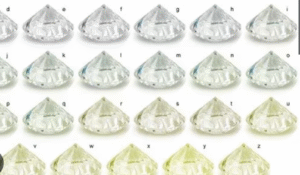Customers usually ignore this. Although diamonds are renowned for representing luxury, love, and refinement, few people know how the hue of a diamond will affect the look of its jewelry. In this post, we will examine how the color of the gemstone influences the attractiveness of the diamond and provide guidance on making a sensible selection for your fine jewelry. We advise you to contact Rare Carat, a credible website for those wishing to purchase diamonds, for the greatest possibilities. Rare Carat offers consumers a wide range of options as well as resources and professional guidance to help them make wise judgments, therefore streamlining the choosing process Colored Diamond .
Table of contents
Overview and Diamond Colour System One can find perfectly colorless, yellow, or brown diamonds. These hues really affect the value of the diamond and the attractiveness of the gem. From D colorless to Z pale yellow or brown, GIA, the Gemological Institute of America grades diamonds using a scale. This scale would make a diamond with D more valuable than one with Z. But the grading a diamond earns also affects how it looks in jewelry. Rare Carat helps consumers make decisions by knowing more about how to evaluate the color grading system against the appearance of the diamond. The site lets users look for diamonds that satisfy not only their taste in hue but much more Colored Diamond .
How does the color of a diamond influence the general attractiveness of jewelry?
The defining quality of white light reflection on the diamond’s surface is brilliance. Setting a diamond of larger carats, such as D, E, or F, with platinum or gold will undoubtedly give your jewelry that luxury touch, but allow maximum shine. Jurassic diamonds, for instance, appeal in color and dazzle even more when set against whiter gold; they are within D and E limits and have the maximum clarity with minimum internal and exterior flaws.
Rings, earrings, and bracelets
Rings, earrings, and bracelets favor less colored diamonds, D and F, with shockingly high sparkle; G-Z diamond ratings are suggestive for necklaces. D to F rated diamonds are definitely highly sought for in light reflecting jewelry since a ring set with a D to F diamond would surely show tremendous emotion to the owner and to onlookers both. The other Z-rated color diamonds are diet-suited for passive eye-captivating necklaces since they are more colorful but low in sparkle, which makes them unfit for multitasking.
Effects of Diamond Color on Light Reflection
Using diamonds rated with D-Z ratings will help to greatly boost the appeal of diamond jewelry. While less colorful diamonds rated low in sparkle end up dominating all other jewelry, D-E rated gems, carefully observing colorful patterns, usually sit in the Z border.
Still, in jewelry, especially when set in rose or yellow gold, diamonds with a color grade of G to J can appear magnificent. The yellowish tinge of the gold enhances the brilliance and beauty of the diamond. This is the reason one should consider the
The Visual Effects of Colors on a Diamond
Even if a given measuring system rates the color of a diamond, other elements could affect the piece’s actual look. For instance, a diamond with a color grade of H could look exactly like a more costly stone if it is smaller or set with something that would accentuate the diamond’s brightness.
Looking at diamonds on Rare Carat, their tools and professional advice enable you to evaluate the color of the diamond to be sure it satisfies your criteria. For example, rarecarat.com features a comparison tool that lets jewelers evaluate how several diamonds look side by side, therefore guiding their choice of diamond for their jewelry set.
How Lighting Affects Diamond Color Sensitivity
The color impression of a diamond also mostly depends on the lighting utilized during view-through. Higher color-grade diamonds are brilliant and clear; lesser color-grade diamonds can seem more brownish or yellowish in natural light. The variances in colorless and near colorless diamonds are more noticeable in artificial lighting, such as fluorescent or incandescent light.
Indeed, the lighting directly influences the style of jewelry or even diamonds. If you want, you could find that a diamond with a much lower color grade is equally beautiful in a mounted necklace as a better color graded diamond.
Your Jewelry’s Perfect Diamond Colour
The choices are many, and color preference is always personal. The style of the piece also dictates color choice based on the design of the jewelry and the metal to hold the diamond. For instance, since a D to F color diamond ring is sparkling, it would be fitting when purchasing one. Choosing somewhat lower-rated diamonds is reasonable if the diamond will be utilized in earrings or pendants, as size alone makes them overwhelming.
Rare Carat is among the top options available should you be considering where to get a diamond of a particular color grade. The site provides just what moves your thoughts towards it; full tools with user-friendly interfaces, along with guidelines created by diamond professionals.
A reliable diamond vendor is rare.
Rare Carat is an excellent place to start if you are looking for a trustworthy provider of a diamond that will complement your style. Their reputation is for offering a large selection of diamonds from reputable vendors at reasonable rates. Their services let one easily compare several criteria, including color, clarity, and carat weight of the diamonds on offer. Therefore, with Rare Carats, you are guaranteed to obtain a diamond that satisfies your budget demands as well as diamond quality and appeal beyond what was imagined. Apart from the simple interface of Rare Carat’s website, visitors also receive customised help to ensure they can locate the diamond that fulfills all their criteria.
Diamond directly affects
The hue of a diamond directly affects its settings in jewelry, thereby affecting the brightness, light interaction, and general beauty. The final result depends on a thorough evaluation of the specifications one sets in addition to the color grading of the products. Using the innovative techniques provided by Rare Carat, they guarantee that all judgments taken regarding the choice of diamond are properly balanced towards the appeal that the jewelry will show alongside the beauty bound to be gained through the diamond itself.
Search Rare Carat to get a range of diamonds. This is the best website for diamond buying. From engagement rings to necklaces, earrings, and bracelets, diamonds define the focal point of classic design. Of the Four Cs of diamond quality—cut, carat, clarity, and colour—color is sometimes the most misinterpreted. Although some say the color of a diamond has little impact Colored Diamond
Recognizing Diamond Colors
Standard diamond color grading scale devised by the Gemological Institute of America (GIA) spans D (colorless) to Z (light yellow or brown). Extremely rare and hence more costly are colorless diamonds (D–F). Yellow or brown hue gets more obvious as you descend the scale, approaching Z.
A white diamond’s reflectance increases with decreasing color, therefore producing more brightness and sparkle. It is more difficult to ascertain, nevertheless, if the color grade significantly influences the appearance of a diamond when set in jewelry Colored Diamond .
Does color matter in jewelry from everyday life?
The real-world situation is significantly different, even if lab settings with ideal illumination and side-by-side comparisons can clearly show colour variations between D, G, or J graded diamonds. Particularly with varied metals and patterns, a diamond set in rings or necklaces can dramatically affect color perception.
Important Elements Affecting Perception of Diamond Colour: Type of Metal: Setting Colour: White gold or platinum settings often accentuate any yellow hue in a diamond. Conversely, yellow or rose gold can hide the warmth of lower-color diamonds (such as H–K), therefore rendering them whiter than they should be Colored Diamond .
little 0.50-carat J-grade diamond
The hue is more obvious the bigger the diamond is. A little 0.50-carat J-grade diamond would seem colorless, while the same grade in a 2-carat diamond would highlight more coloration.
Lighting Conditions: A diamond’s color may change under warm indoor or natural daylight. Cool lighting accentuates whiteness; warmer lights could highlight yellow undertones.
Brilliant cuts like round reflect more light and can hide minor tints. Like emerald or asscher, step cuts feature additional facets that highlight inclusions and color.
Accent Stones: Smaller diamonds of higher or lower colour grades either accentuate or detract from the beauty of the central stone Colored Diamond .
Human Sensibility of Colour and Perception
Most individuals, surprisingly, cannot see minute variations in color tones unless they are side-by-side under ideal conditions. For instance, without direction, the average person might not be able to tell a G from an I colour diamond.
According to a GIA study, even experienced gemologists find it difficult to distinguish color grades when diamonds are set in jewelry. Practically speaking, then, color has little bearing on the apparent attractiveness of a diamond unless the difference is clear-cut (such as a D against an L).
How Would One Personally Discover?
You can follow these useful guidelines to find out whether the color of a diamond will impact its appearance in a given piece of jewelry Colored Diamond :
1. View Side by Side
Ask your jeweler to display to you side-by-side, under the same lighting conditions, varying color grade diamonds. This will help you to appreciate the true impact a color grade has on your eyes.
2. View under Multiple Lighting Conditions
Under a variety of lighting—daylight, warm, LED, etc.—examine the diamonds. This model’s actual wear.
3. Test in Final Setting
See the diamond in its natural habitat before deciding at last. Your impression of the diamond’s hue may be quite changed by the color of the metal.
4. Think about Shape and Cut.
If you are using a form that hides color well, such as a round brilliant, you can use a lesser color grade with no obvious effect.
5. Ask for a Grading Certificate.
Every respectable jeweler should offer a GIA or another equivalent accreditation. See the color grade and match it to your taste in visuals.
Is it justified to pay more for better color grades?
This boils down to taste and financial means. Although D-F color diamonds are rare and demand a premium price, their appearance in jewelry, especially in smaller carat sizes or yellow gold settings, is not always clearly superior. Perception
Most individuals, surprisingly, cannot see minute variations in color tones unless they are side-by-side under ideal conditions. For instance, without direction, the average person might not be able to tell a G from an I colour diamond.
Diamonds in the G–I category
Most consumers find that diamonds in the G–I category provide a great mix between cost and look. Especially when cut beautifully and set in complementary metals, these diamonds may seem colorless to the unaided eye. In what way can I find out whether a diamond has a yellow tint? Under neutral lighting, side-by-side comparison with a higher colour grade stone is advised. When a diamond is set against a colorless one, one can easily discern if it has a warm tone.
Considered colorless is what color grade? GIA criteria classify grades D, E, and F as colorless. When shopping for a diamond, should I give cut or color top priority? Cut affects a diamond’s sparkle and brilliance more broadly. Often, a well-cut G or H color diamond looks nicer than a badly cut D color diamond.

How Could One Find Out Whether the Colour of a Diamond
Final Thought:
Realistic Over Perfection Jewellery is meant to be worn, appreciated, and worn, not examined under close inspection with magnifying glasses. Although color is a basic feature of a diamond, it shouldn’t be the only consideration as you decide what to buy. Every piece of jewelry is different because color interacts with setting, lighting, size, and personal tastes.
Human Sensibility of Colour and Perception
Most individuals, surprisingly, cannot see minute variations in color tones unless they are side-by-side under ideal conditions. For instance, without direction, the average person might not be able to tell a G from an I colour diamond.
Conclusion
Pay more attention to how the diamond looks to you than on chasing excellence (and price tags) in colour grades. Why pay the fee if you cannot distinguish a H from a D without guidance?
Does a diamond’s color then influence its appearance in jewelry? The quick response is: sure, but not necessarily in ways that the typical eye finds important. A diamond’s appearance is much influenced by several elements, including setting, cut, illumination, and personal color sensitivity; so, the effect of color is sometimes subtle. Although their purity makes colorless diamonds valuable, nearly colorless stones can provide almost perfect beauty for a far lower cost.
The best approach to strike the ideal mix between cost and looks is to know your own tastes and test diamonds in actual environments. The emotional resonance and personal meaning a diamond adds to the wearer ultimately define its appeal more than its technical grade Colored Diamond
FQS
Q1: For an engagement ring, what color diamond would be most suited?
G–H colour diamonds are common for engagement rings since they seem almost colourless but are far less expensive than D–F grades. They particularly look great in white gold or platinum settings.
Q2: Would picking a lower color grade help me to save money?
A: Sure. Particularly in yellow or rose gold settings, selecting an I or J color diamond can provide excellent value without sacrificing beauty.
Q3: Are white diamonds of low grade the same as colored diamonds?
A: No. Considered “fancy” and with their own grading system are coloured diamonds like pink or blue. Rare and typically more costly than white diamonds, these are also colored diamonds
Q4: Does diamond form influence color perception?
A: Absolutely. Round brilliant cuts tend to hide colour better because to their glitter, while step cuts like emerald or Asscher disclose more colour due to larger facets.
Q5: Is a D colour diamond worth the extra cost?
A: Only if you are shopping for a high-end product or particularly appreciate complete colorlessness. Lower color grades can also seem quite beautiful in the proper context Colored Diamond. https://liferools.com/wp-admin/post.php?post





Leave a Reply